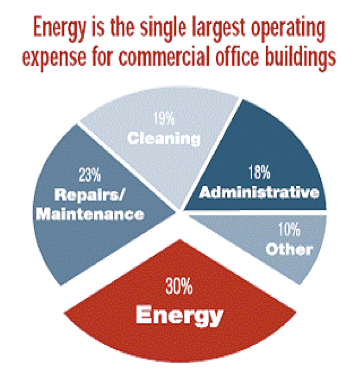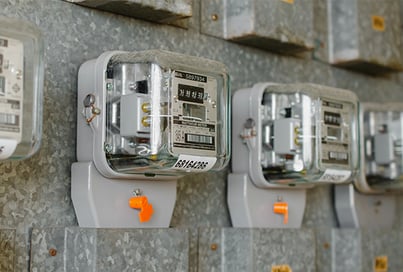Energy consumption is at the core of expenses incurred by commercial buildings. Commercial building occupants, irrespective of season or climatic condition, usually consume energy through heating, ventilating or air-conditioning, in what is popularly termed as the HVAC System. The plus side of energy consumption as an expense is its variability. Capitalizing on the variable nature of energy consumption, players in the commercial building energy space are increasingly innovating and developing new strategies aimed at optimizing energy efficiency through energy savings.

Image source: https://www.chappleelectric.com/images/Commercial-Buildings-Costs.png
What then is energy savings? Energy savings refers to unused energy that would have otherwise been consumed if certain energy saving actions had not been implemented. Over the years, the aspect of energy savings has grown to become a huge niche in both the energy and commercial building industries, with entire companies been built and structured around providing energy savings needs.
There is however one question who’s varying answers and approaches keeps the aspect of energy savings from unanimity: How to calculate/assess energy savings? For all intents and purposes, energy savings is unused energy resulting from the implementation of energy savings actions. This unused energy is however not stored in a particular place, where it could be accessed and measured. So how then is energy savings being calculated and ascertained? As a reaction to this question, the industry developed a standard formula:
Energy Savings = (Baseline energy use) adjusted – (Post-installation energy use)
Though the formula might come across at first glance as being simply linear and straight forward in terms of applicability, the “adjusted” part of the formula is where all the divides are originating from. Though there is a general consensus on the point that the weather is a major aspect for which adjustments are to be made, there is however no such consensus on how to go about it. Measurement and verification (M&V) of these savings involve energy efficiency projects that are becoming increasingly popular today. The primary purpose of M&V is to validate that the resources spent (time, effort and money) to reduce energy usage in buildings provides the expected results. This is done by measuring the savings generated in any energy efficiency project including but not limited to major renovations, retrofits, facility improvements, and operational and behavioral changes. These projects are generally implemented by a building owner or sometimes through professional services such as energy service providers, equipment manufacturers, financial service providers and utilities.
M&V is often used in energy-related government incentive and education programs, utility rebate programs, and contractual arrangements between two or more parties involved with the delivery of energy efficiency projects with guarantees of energy savings.
Here are some questions to ask before assessing energy savings in M&V projects.
1.What was the baseline consumption of the commercial building before the implementation of energy savings?
This question is critical as it serves as the starting point for the assessment of energy savings. The baseline consumption refers to the value of energy consumption (either in energy measurement units or monetary units) within a definitive time period before the implementation of energy savings techniques. It is so called the baseline period because the values observed and recorded during this time will be used later on as the base in assessing the energy savings resulting from the implementations carried out on the commercial building. The baseline period could be in days, weeks, months or a year.
2. What were the expected energy savings at the time of implementing the energy savings measures?
Understanding the expected project milestones and achievements at the time of implementing energy savings measures is important in assessing the actual energy savings resulting from an M&V project. Knowing the expected savings gives an understanding of the methods and procedures used by the energy savings contractor in assessing energy savings on commercial properties. This will in turn give you an opportunity to determine if there are any loopholes in the procedure that might alter the expected savings. These loopholes will therefore be taken in to consideration when assessing the final energy savings.
3. What is the duration of the project implementation?
The duration here will refer to the time period that elapses between the time of implementation and the time of assessment. This could be in months, seasons, weeks, days or even a year. What are of primary concerns with respect to the duration are weather/climatic fluctuations. These are important because they make up a major part of the adjustments sector of the formula. For example, there is an obvious difference between heat energy consumption in winter and in summer. It will therefore be unrealistic to compare heat savings between the two periods without making adjustments to the base period’s consumption based on the impact of adjusted weather readings.
4. What adjustments are to be made?
The effectiveness of an energy savings value is hugely dependent on the adjustments to be made to the baseline period. Adjustments here will refer to mathematical alterations to be made, so much so that baseline conditions equate conditions at the time of running the energy savings measures, on a mathematical level at least. If say heat consumption at -3o in winter was 24 Kw before the implementation of energy savings, with it being 4 Kw in summer at 23o after implementation, mathematical computations will have to be carried out to level the weather conditions in an effort to determine if there has actually been any energy savings at all, and at what rate.
5. Are the energy savings techniques cost effective?
The reason why commercial buildings opt for energy savings in the first instance is to cut cost. It is therefore irrational for the commercial building to end up with another cost which is higher than the benefits of the cost to be managed. When assessing energy savings in a measurement and valuation project, you will have to take in to consideration how much it costs the commercial building to install and continue running the energy savings projects against the actual benefits been derived from the implementation. If indeed there are gains in energy savings which fall below the cost of running the energy savings project, the program should either be modified or scraped.
6. Which M&V protocol is being followed?
When it comes to measurement and valuation, there are several protocols out there that could be used in assessing energy savings. Each of these protocols in turn has their own unique procedure which will have to be taken in to consideration when assessing energy savings. Knowing and acquainting oneself with the M&V protocol with which to assess the energy savings of commercial buildings is therefore of importance. Most M&V projects however follow the IPMVP protocol, which is widely accepted than any other protocol in the building energy sector.
7. In which building sectors are energy savings measures implemented?
Energy savings as a project can either be implemented in sectors of commercial buildings or in the entire building. When the time therefore comes to assess the energy savings resulting from the project, it is paramount that the assessment only be done for those sectors in which implementation took place. The readings of an energy savings assessment will be wrong, if all the energy sectors of a commercial building are being taken in to consideration, when implementations were only done on particular energy consuming sectors. The effect of the whole will therefore negatively impact the results from the implemented parts.
8. What is the yield of the energy savings projects compared to that of similar projects in the industry?
In providing energy savings for a commercial building, the aim is to optimize savings as much as possible. When assessing savings as part of an M&V project, the assessment should be comprehensive, i.e. it should take into consideration every aspect (competitor analysis inclusive). Comparing the results of the current project to those of similar projects in the industry will enable you determine whether or not the commercial building is being served the best technique available. In a situation where this comparism leaves the current project on the down side, modifications will have to be made so as to reach the industry optimum.
Conclusion:
In conclusion, energy savings are typically assessed using Measurement and Verification (M&V) methods. M&V helps with the standardization and consistency of measuring energy savings. There are many factors that need to be considered before assessing these energy savings. Some of them are 1.the baseline energy savings, 2.expected energy savings 3.duration of the project 4. What adjustments are being made 5.energy savings techniques 6.M&V protocols 7.the building sectors involved and 8.the yield of the energy saved. Considering all these questions will help you not only meet your energy savings goals but also ensure efficient implementation of your M&V process.





